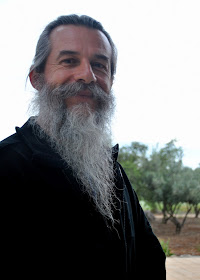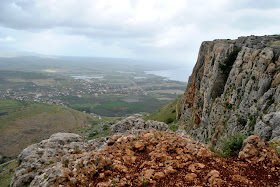After we left Arbel Cliffs, we drove along the north edge of Lake Gennesaret or Kinneret (known also as the Sea of Galilee). Jesus and His disciples would have walked along the sea, and somewhere in this area Jesus would have taught the multitudes who followed after Him.
We visited the Church of the Beatitudes, located near Tabgha and Capernaum, where tradition says Christ gave the Sermon on the Mount, although this might have taken place over time, not necessarily in one setting. (Matthew 5-7)
I have to say that I am just not so keen on these churches (shrines) being built here. I guess some find them worshipful places, but I prefer the outdoors and wish they would just have left the beauty of the area "as is".
Looking back to the cliffs we had been on earlier in the day.
In the photo below, looking at the "other side" of the Sea of Galilee. Jewish people in Biblical times would
not go to the "other side". The Second Feeding (of 4,000) took place on the other side in the pagan Decapolis area and was meant for the new people of God, made up of Jews and Gentiles. The 7 baskets left over were symbols of the 7 Nations originally expelled from the land by the tribes of Israel, but now invited to take part at the table of the Lord.
* * * * *
We also visited the Loaves and Fishes Church at Tabgha.
The church is modern but stands on the site of 4th and 5th-century churches. During the time of Christ, Tabgha was considered the lonely place where Jesus withdrew to frequently. In the first 4 centuries a large community of Christians of Jewish descent lived in Capernaum and kept alive the memory of Jesus' presence at Tabgha, passing these traditions on from generation to generation.
Besides its supposed place of a miracle of Jesus, one of the main highlights of the Church of the Loaves and Fishes is this beautiful 5th-century mosaic floor. It is the earliest known example of a figured pavement in Palestinian Christian art.
This is the traditional stone on which the miraculous meal was laid. Or where Jesus sat on. Evidently, in early years people would chip away pieces of this stone for good luck. Now, it is blocked off so people can't do that.
The first feeding of the multitude with 12 baskets left over signifies, according to ancient tradition, the 12 tribes of Israel.
Of course, it is not really known for sure that these are the actual places Jesus did these things. What is important is that He did them. He proved over and over that He is the Messiah, the Rescuer of mankind.
What He said raised the eyebrows of the religious elite (and their anger). "He wasn't like the teachers of the Law; instead He taught with authority." What He said reaches across people culturally, politically and for all ages. His Word is timeless. And it speaks to the heart!
When He fed the 5,000, this was a Jewish audience, on their way to celebrate the Passover. Passover was a time to remember God delivering Israel out of Egypt and providing for them in the wilderness through the miraculous provision of food and water. And now Jesus did the same thing for these people. He more than satisfied the hunger of thousands!
And He satisfies our "hunger" too.
"Blessed are those who hunger and thirst for righteousness, for they will be filled." Matthew 5:6
Satisfy us in the morning with Your unfailing love, that we may sing for joy and be glad all our days. Psalm 90:14



















































.jpg)







